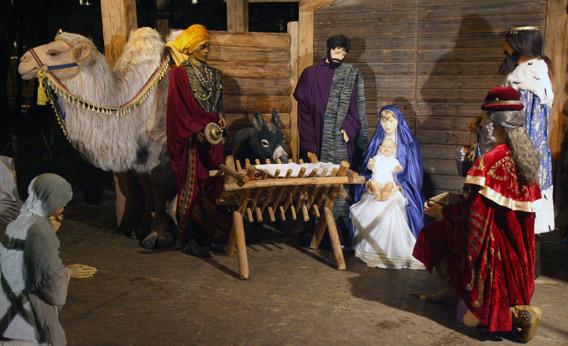The Holy Family With Saint Francis Popular Scene in Art History
Who Staged the First Nativity Scene?
Hint: The Yr was 1223.

A traditional religious Nativity scene in front end of the Roman Catholic Cathedral of Vilnius, Lithuania
Photo by Petras Malukas/AFP/Getty Images.
Just as many families take treasured decorations—wreaths, ornaments, and nativity scenes—out of storage each vacation season, Slate reaches into its archives to share some of our favorite old pieces. Final year, L.V. Anderson explained the origins of the Christmas nascence scene. The original article is below.
It's nearly impossible to go through December without seeing at least one nascency scene, whether it's a set of ceramic figurines in a individual home, a life-size tableau in front of a church building, or a cast of actors in a children's pageant. And rarely does a yr go by that these representations of Jesus, Joseph, Mary, the three wise men, some shepherds, and miscellaneous befouled animals go unmolested by vandals or unchallenged by lawsuits. Why do people put upward crèches at Christmastime, anyhow?
Blame St. Francis of Assisi, who is credited with staging the commencement nativity scene in 1223. The only historical account we have of Francis' birth scene comes fromThe Life of St. Francis of Assisi by St. Bonaventure, a Franciscan monk who was built-in five years before Francis' death. According to Bonaventure'southward biography, St. Francis got permission from Pope Honorious Three to set up a manger with hay and two live animals—an ox and an ass—in a cavern in the Italian hamlet of Grecio. He then invited the villagers to come up gaze upon the scene while he preached about "the babe of Bethlehem." (Francis was supposedly so overcome past emotion that he couldn't say "Jesus.") Bonaventure also claims that the hay used by Francis miraculously acquired the power to cure local cattle diseases and pestilences.
While this part of Bonaventure's story is dubious, information technology's articulate that nativity scenes had enormous popular appeal. Francis' display came in the center of a catamenia when mystery or miracle plays were a popular form of entertainment and education for European laypeople. These plays, originally performed in churches and later performed in boondocks squares, re-enacted Bible stories in vernacular languages. Since church services at the time were performed only in Latin, which virtually no one understood, miracle plays were the only way for laypeople to larn scripture. Francis' nativity scene used the same method of visual display to help locals understand and emotionally engage with Christianity.
Within a couple of centuries of Francis' inaugural brandish, nativity scenes had spread throughout Europe. It'due south unclear from Bonaventure'southward account whether Francis used people or figures to stand in for Jesus, Mary, and Joseph, or if the spectators simply used their imagination, but later nativity scenes included both tableaux vivants and dioramas, and the cast of characters gradually expanded to include not but the happy couple and the infant, only sometimes entire villages. The familiar cast of characters nosotros see today—namely the three wise men and the shepherds—aren't biblically authentic. Of the iv gospels in the New Testament, only Matthew and Luke describe Jesus' birth, the former focusing on the story of the wise men'south trek to see the infant king, the latter recounting the shepherds' visit to the manger where Jesus was born. Nowhere in the Bible do the shepherds and wise men appear together, and nowhere in the Bible are donkeys, oxen, cattle, or other domesticated animals mentioned in conjunction with Jesus' nativity. But early nativity scenes took their cues more from religious art than from scripture.
After the reformation, crèches became more than associated with southern Europe (where Catholicism was still prevalent), while Christmas copse were the northern European decoration of choice (since Protestantism—and evergreens—thrived at that place). As nascency scenes spread, different regions began to have on dissimilar artistic features and characters. For example, the santon figurines manufactured in Provence in France are made of terra cotta and include a wide range of villagers. In the Catalonia region of Spain, a effigy known as the caganer—a young boy in the act of defecating—shows up in near nascence scenes. In xxth- and 21st-century America, nativity figurines became associated with kitsch rather than piety, with nonreligious figures like snowmen and rubber ducks sometimes occupying the main roles.
What about those nascency plays that children often perform at Christmastime? They are an obvious outgrowth of the miracle plays of the Middle Ages, but the reason children (rather than adults) perform in them isn't clear. However, information technology'due south possible the tradition stems from the Victorian Era, when Christmas was recast in America and England as a child-friendly, family-centered vacation, instead of the rowdy celebration it had been in years by.
Got a question about today'southward news? Ask the Explainer.
Explainer thanks Bruce Forbes of Morningside College, the author of Christmas: A Candid History.
Source: https://slate.com/human-interest/2013/12/history-of-the-christmas-creche-st-francis-invented-the-nativity-scene.html
0 Response to "The Holy Family With Saint Francis Popular Scene in Art History"
Post a Comment